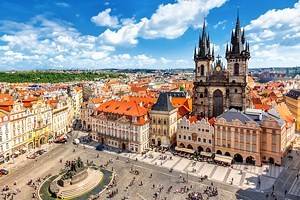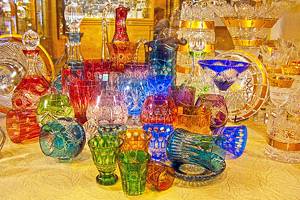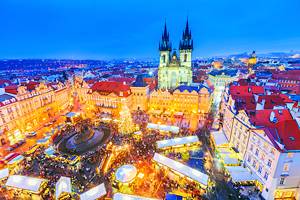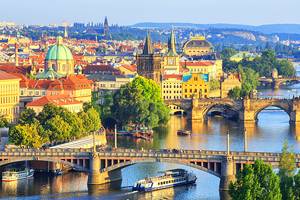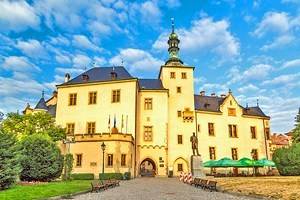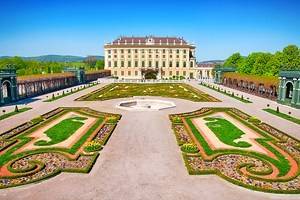Cities in the Czech Republic
The Czech Republic is filled with stunning cities offering world-class museums, architecture from empires past, and cosmopolitan fun. You could spend days exploring Prague and its many historical corners, but there are plenty of other cities in the country that are also worth visiting.
The country also has many remarkable squares and parks, picture-perfect alleyways that seem out of a fairy tale, and a bohemian lifestyle that will appeal to artists and dreamers alike.
Whether you're looking for quirky attractions, breathtaking castles, or some unique cuisine, you'll find it all in our list of the best cities in the Czech Republic.
Prague

Known as "the city of the 100 spires," Prague's medieval architecture and fairy-tale red rooftops are just part of the reason the city feels like out of a dream. Home to Prague Castle, the world's largest castle complex at Vyšehrad, and one of Europe's oldest bridges (Charles Bridge's construction started in 1357), Prague is also host to many other amazing attractions, including the world's oldest astronomical clock still in operation.
Because Prague wasn't severely bombed during WWII like other European capitals, the Old Town Center remains intact, a place where cobblestone streets, UNESCO World Heritage Sites, and ancient buildings still stand.
For those looking to discover Prague's artsy background, Modernist writer Franz Kafka was born here, and The Estates Theater where Mozart premiered his opera Don Giovanni still offers performances to this day.
Plenty of historical and quirky museums dot the city too, including the Museum of Communism and the 12th-century library at the Strahov Monastery. You can even tour a real nuclear bunker from the Cold Era.
Some of the best art can be found outdoors – just go on a hunt for massive David Černý's sculptures, which include giant crawling babies in city parks and St. Wenceslas riding an upside-down horse inside one of the many historical shopping passages in Prague.
Český Krumlov

When it comes to cities that pack on the charm, Cesky Krumlov takes the top spot. A UNESCO World Heritage city center, a stunning castle home to one of the few surviving Baroque theaters in Europe, and a number of medieval buildings with facades covered in original frescoes top the list of amazing things to see and do in Cesky Krumlov.
The Vltava River runs through the city, just steps away from the castle. Walk to the top of the castle tower for views over the water or jump right in after renting a raft. Small rapids await downstream as you paddle past medieval architecture and sleepy old towns.
Cesky Krumlov is home to a number of quirky museums, including the Museum Fotoatelier Seidel (focused on 19th-century photography), the Moldavite's Museum (dedicated to meteorites), and the not-for-the-squeamish Museum of Torture.
Kutna Hora

Kutna Hora is most famous for being home to the Baroque Sedlec Abbey and its underground ossuary, a UNESCO World Heritage site that houses the bones of up to 70,000 people who died during the 14th century Black Plague and the Hussite Wars a century later.
The macabre-meets-artistic displays include chandeliers made of bones, a coat of arms, pinnacle-shaped candleholders, and a large area containing hundreds of skulls.
Another stunning sight to see on a visit to Kutna Hora is the Gothic St. Barbara's Church, another UNESCO World Heritage Site, dating back to the year 1388. St. Barbara is considered the patron of miners, once an important industry in the area.
Visitors can now walk 33 meters down a massive staircase into a medieval silver mine located next to the church – its entrance had been blocked until it was accidentally discovered in 1967.
The Gothic Stone House, a museum of silver, is just steps away.
Karlovy Vary
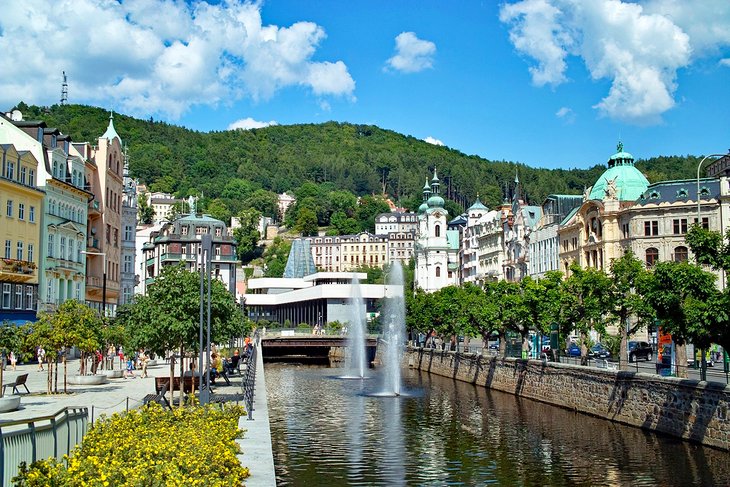
The spa resort town of Karlovy Vary (sometimes referred to by its old German name, Carlsbad) was already a popular destination in the 14th century, and over the centuries has received many illustrious guests, including Chopin, Goethe, and Peter the Great.
Visitors come here mainly for the hot springs, which are supposed to have curative properties because of their mineral composition and carbon dioxide content. Although bathing in the healing waters is possible through spas and special bathing houses, there are also many free water taps located under colonnades throughout the city – each one has a sign showing the water temperature, which can reach up to 100 degrees Celsius.
The Museum of Glass MOSER, dedicated to the famous luxury glass manufacturer, is a must-see here, especially if you want to pick up some discounted pieces to take home. And if you arrive in summer, you might just catch the Karlovy Vary International Film Festival, which attracts Hollywood stars and is the center of a number of activities around the city every August.
If you're up for some sightseeing in Karlovy Vary, the St. Linhart Game Reserve is home to Dybowski's sika deer and other wildlife. Or you can catch a cable car ride to the Diana Lookout Tower for some greenery and great views over the city.
České Budějovice

Not far from Cesky Krumlov, České Budějovice was founded by German-speaking settlers, which completely changed the look of the city. Today, it's famous for its charming Gothic, Renaissance, and Baroque architecture, which includes the 16th-century Black Tower, the former 14th-century prison known as the Iron Maiden Tower, and the church of the Presentation of the Blessed Virgin Mary.
This medieval fairy-tale city is home to excellent cafés and restaurants, especially around the charming central square. In summer, you'll find plenty of markets, festivals, and fairs taking place here as well.
Just nine kilometers from the city is one of the country's most stunning castles, the neo-Gothic Hluboká nad Vltavou Castle. A stunning fortification surrounded by English ornamental gardens, the castle has been impeccably preserved, and visitors can tour the reading room, private apartments, and even the original kitchen.
Brno

The Czech Republic's second-largest city is located in the south of the country, near the border with Austria. A university and cultural hub, Brno is home to many attractions and things to do. Among them is the Špilberk Castle and fortress, which sits on a hilltop and once served as a prison for the Austrian Empire. The Brno City Museum is also hosted inside the castle.
Brno is home to only one UNESCO World Heritage Site, the Villa Tugendhat, considered the most significant example of modernist architecture in the country. But there are plenty of other significant historical buildings in the city as well, including the massive Cathedral of St. Peter and Paul and its 84-meter-tall twin towers and the Moravian Gallery.
Visitors also flock to the city to visit the 14th-century Church of St. James and its underground ossuary; the Capuchin Church and Crypt and its unusual collection of human remains; and a number of great parks, including the 55-acre Lužánky Park in the heart of the city.
Just outside Brno (and a very popular day trip) is the Moravian Karst, a network of over 1,000 gorges and caverns, five of which are open to the public. Veverí Castle, not far from the city center, is also a fun outing that includes not only plenty of historical exhibits but also lots of hiking trails around the castle grounds.
Liberec

Surrounded by the Jizera Mountains that mark the border with Poland, Liberec is perhaps best known for being home to the 94-meter-tall Ještěd Tower. The tower sits at 1,000 meters on top of Ještěd mountain, and in addition to a TV transmitter, it also hosts a hotel, a restaurant, and a ski resort.
Many of Liberec's stunning buildings date back to the 18th and 19th century, when the city was part of the Austrian monarchy under the Kingdom of Bohemia. As a result, the architecture here differs from the rest of the country, with the beautiful Opera House and the North Bohemian Museum good examples of the typical Austrian balustraded balconies and white marble stairways.
Other top tourist attractions in Liberec include the 16th-century Liberec Castle; the oldest zoo in the country; and the nearby Harcov Water Reservoir, a popular swimming and boating destination.
Olomouc

Founded in the 13th century and with a distinctive Baroque style, Olomouc is an exciting destination for those wanting to escape the busyness of the larger cities.
The Holy Trinity Column – built in the early 1700s to celebrate the end of the plague – is the city's most recognizable landmark. A massive 35 meters tall, the column is adorned with stone sculptures and reliefs representing saints, including local figures like St. John Sarkander, who died in prison during the Thirty Years' War.
Nearby, visitors can see the Gothic Olomouc Castle and Saint Wenceslas Cathedral, the 1400s astronomical clock, and the city's famous six Baroque fountains that once supplied water to all residents.
A short ride outside town is the Kroměříž Castle and Gardens with its formal Baroque gardens, and the ruins of the Helfštýn Castle, which holds special exhibitions on medieval blacksmithing and minting.
As the largest city in the Moravian region, Olomouc is also a great culinary destination, where you can try traditional dishes like potato dumplings served with the famous tvargle or Olomouc cheese, a very strong cheese that has been produced with the same recipe since the 15th century.
Hradec Kralove

The name Hradec Kralove (literally "queen's castle") refers to the presence of a castle in the area as far back as the year 1119. However, despite a number of impressive structures and fortresses being built in the city over the years, there's currently no castle in Hradec Kralove.
Visitors will still see plenty of amazing buildings here, including the 14th-century Cathedral of the Holy Spirit and the White Bell Tower, home to one of the best bells in the country.
With a long history of culture and drama, it's no surprise Hradec Kralove is a major theater destination. In addition to the Klicpera Drama Theater, there's also the Drak Puppet Theater, and the REGIONS International Theatre Festival.
But one of the best things to do in this charming city involves mostly walking its narrow alleyways, flanked by colorful houses, and exploring the many parks.
Plzeň

Plzeň is the birthplace of the Škoda automobile company, the only Czech car brand still being produced in the country.
But this small city less than 100 kilometers from Prague has plenty more to offer, including a charming Old Town center with colorful houses and picturesque architecture. Highlights include the 1901 Neo-Renaissance Burgher's Hall and the West Bohemia Museum.
A maze of cobblestone streets leads visitors to the Republic Square (Náměstí Republiky), with its 1200s St. Bartholomew´s Cathedral (head to the top of the 100-meter-high tower for great open views) and three abstract fountains installed in the 2000s.
Not far is the St. Mary's plague column and the beautiful J.K. Tyl Theater, which produces over 600 ballet and opera shows every year.
Filled with markets and fairs throughout the year, the city also hosts the very unique DEPO2015, a cultural space that combines interactive exhibitions, art studios, and a hall for concerts and shows.
Ostrava

Located near the border with Poland at the confluence of four rivers, Ostrava has long been considered a mainly industrial city. For centuries, it was the main coal-mining urban area in the country, and later on a major metallurgical center.
Things have changed much since the 1990s, though, and the few industrial sites that remain in the city are now considered of historical heritage. The Lower Vítkovice area is home to the city's most significant industrial architecture and a tentative UNESCO World Heritage Site.
A number of coal mines and blast furnaces used in the production of iron are now known as "the town of steel," where visitors can explore a labyrinth of iron towers and pipes. A newly-built glass elevator goes up to a viewing platform on the tallest furnace.
Those walking around the city center can catch the clock at the Ostrava's Puppet Theater performing throughout the day, visit the Silesian Ostrava Castle, or walk the historical streets of the city to discover Functionalist, Socialist realist, and some Renaissance and Classicist architecture.
Ostrava is home to a large number of unique museums, including the Michal Colliery mining museum, the only firefighting museum in the country, a museum dedicated to antique toys, and the blacksmithing and coal-mining Keltička's Forge Museum.









